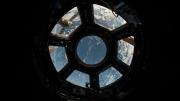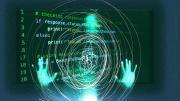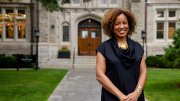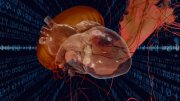Press the "play" button in the video screen above to take a guided tour of the 3-D PDF with Alyssa Goodman. Then explore the Perseus molecular cloud for yourself: click here to view the 3-D PDF. Try out the features on your own, or follow the instructions below.
Important: The above-linked PDF loads properly only in Adobe Reader or Adobe Acrobat (version 8 or newer). The 3-D functions do not work correctly when viewed in a Web browser or other PDF viewer such as Preview. Download the Adobe software free of charge here.
The image that loads by default shows the L1448 region of the Perseus molecular cloud, analyzed using the dendrogram algorithm developed by Erik Rosolowsky, Alyssa Goodman, and colleagues. Using your mouse, click and drag the image to rotate it and view the same region from the side, from behind, or from above or below. You can always click the "home" button in the toolbar to return to the original view.
To zoom, click the "magnifying glass" image in the toolbar and then drag your mouse upward (to magnify) or downward (to shrink) along the image.
You'll see two sets of options on the left-hand side of your screen. Both allow you to add different categories of data to (or remove them from) the image. "Dendrogram decomposition" refers to what you see in the default image, the output of the dendrogram algorithm. "CLUMPFIND decomposition" refers to the output of the older algorithm that didn't acknowledge hierarchical structures (very dense areas nested within other dense areas). Check one box and uncheck the other to view these two separately; keep both boxes checked to see how the two analyses of the same Perseus region overlap. The "billiard markers" provide a set of landmarks to help you keep your bearings as you examine and rotate the two images: they mark the locations of the four most significant self-gravitating structures (see below). The last option in this list allows you to turn on or off the labels of the axes (two dimensions in space and one of velocity).
The second menu offers several more different views of the dendrogram and CLUMPFIND output. Note, in particular, the second option in the list, "dendrogram: self-gravitating structures." Self-gravitating structures are pockets of matter so dense that the particles are close enough to one another that gravity takes hold. Scientists look for these pockets as clues to where stars will form. If you rotate this image to view it from the side, you can see that the self-gravitating material in this region divides into two patches, one bigger and one smaller. Without 3-D imaging software—adapted from medical-imaging software by Michael Halle and colleagues at Brigham and Women's Hospital and the Initiative for Innovative Computing—the scientists could not have learned that these two patches are separate; the gap between them is not visible from the front view, or the perspective from the direction of Earth, which is all telescopes can provide.








